Scabs on the scalp are raised yellow patches or crusts on the head. They can also be black, dark brown or even red.
Most people with these complain of an itchy scalp with sores that appear randomly and may bleed at times.
Here are causes, treatment options and how to stop picking the little scabs forming on your head.
What is scabbing on the scalp? It is the formation of minor lesions, usually caused by scratching your head, tight braids, pulling dreadlocks or any form of trauma that can cause the skin on your scalp to break. As it heals, after bleeding, small crusts form.
These are called scabs. Below, and throughout the page are pictures of scalp scabs to help you identify them easily. The photos will also help you distinguish them from scalp bumps, infected pimples, and sores.
Causes
Sores and crusts on the head have causes including cancer, hair care procedures such as braiding, dyeing, bleaching, relaxing and braiding.
Scalp problems such as eczema, dandruff, itchy scalp and head lice may also cause lesions and sores on the scalp.
1. Itching and scratching
Scratching your head bruises the skin. It is a result of an itchy scalp. The skin breaks causing small lesions and sores form from the initial bruises that you cause. As the lesions start to heal, you end up with small scabs on your scalp.
The best way to prevent itching is to treat the underlying cause, such as severe dandruff, eczemas, cancer, head lice and nits, and sometimes, irritating hair care products such as shampoos, relaxers, and even hair oils.
2. Psoriasis or eczema
There is a difference between eczema and psoriasis, but both can cause scalp scabbing. Eczema on the head appears as areas of the skin that are irritated, red and itchy.
As a result, you will end up with white flakes in your hair. These are dandruff. The common symptoms of scalp eczema include the following:
- Flaky, scaly areas
- Irritation
- Oozing lesions from blisters
- Waxy or greasy scalp.
Psoriasis, on the other hand, also causes crusts on your scalp, but manifests itself with symptoms such as red raised patches. These patches are usually scaly or flaky. As they heal, they will form sores and scars.
According to Lindsey Marcellin, MD, MPH of EverydayHealth, “Scalp eczema often responds to treatment, but it also often returns.” This could be the cause of small scabs that won’t go away or keep coming back, recurring and won’t heal.
3. Dyeing hair or hair dye
Do you get sores and itchy scalp after applying hair dye? Scalp irritation comes from allergic reaction and irritation from hair products such as hair dye, shampoos, and even jewelry.
Allergic reaction from hair dye is characterized by mild to severe itching. The common ingredient in hair dyes and hair colors that causes scalp irritation, itching and eventually scabbing is para-phenylenediamine. You can prevent these side effects by buying hair dyes without this ingredient.
4. Dandruff
Dandruff can affect anyone from babies to women during pregnancy and even men.
According to Mayo Clinic, dandruff is a long-term condition that can be difficult to treat or get rid of.
Dandruff can cause your skin to be flaky, itchy and scaly.
When dandruff is severe, it causes reddish or yellowish, scaly pimples, usually along the hairline, behind ears and at the back of the head.
When pimples break, they start healing by forming pimple scabs on the head and areas affected. This can include eyebrows.
5. Tight braids, perm, weave and extensions
Another cause of white and yellow scabs on the head is hairstyling procedures. Was your hair done too tight and dry? Tight braids, weaves, extensions, and perm can strain the skin on your scalp, causing it to break.
The lesions that form along the hairline may start bleeding and end up causing sores. To prevent these symptoms, avoid hairstyles that strain your scalp skin or cause it to break.
6. Cancer
The Cancer Research UK suggests that a scabbing scalp could be a sign of cancer and should not be ignored. This is especially if you get them and the crusts keep bleeding for more than 4 weeks without healing.
Skin cancer is one of the most dangerous forms of melanoma that has a rate of fatality almost double the rate of cancers forming elsewhere.
Other than the wounds that won’t heal, look out for other cancer symptoms such as the following.
- An itchy spot on the scalp that hurts, scabs over and bleeds more than four weeks.
- Pink or red bumps that appear to be shiny and keep growing.
- Sores that may turn into ulcers on the head.
7. Lice and nits
Although lice do not transmit disease, they are unsightly and can cause a lot of discomforts. People with head lice usually feel small things moving in the hair, which prompts scratching. The itch will lead to too much scratching, which will then lead to scalp scabs and sores.
Secondary infections may arise from the abrasions on your head. Some experts note that symptoms of head lice in some people include hives, scabs and sometimes visibly enlarged neck nodes. Nits on hair follicles or shafts will also be visible.
8. Lupus and HIV
The Lupus Organization in the United Kingdom advises that discoid lupus produces scalp lesions and scabs as one of the pronounced symptoms.
Itchiness, peeling of skin on the scalp and redness may also be visible in patients with lupus. As a result, scarring on the scalp, hair loss and rashes will form.
HIV, a sexually transmitted virus can also come with a host of complications. Generally, the immune system is weakened, leaving the body vulnerable to all sorts of attacks.
Skin disorders that may arise include – among many others – warts, seborrhea, scabies, molluscum and itchy, scaly plaques on the scalp. It is important to note that spreading scabs on the scalp are not, singularly, a symptom of HIV and AIDS.
9. Shingles and ringworm
Shingles is a viral rash that is painful and causes an eruption of blisters on the skin. It is also called herpes zoster.
When symptoms of shingles appear on the scalp, you will notice the formation of patches of small crusty scabs on the head. These occur when the blisters dry up, crust over and form a scab.
Ringworm is a fungal infection, mostly in children but can appear in adults too. It accounts for about 30% of hair loss cases in children.
When attacked by the fungus, you will get circular clusters of pustules around the affected area on your head. When they dry, they will form little scalp scabs and crusts.
9. Oily (greasy) scalp
An oily scalp is also prone to scabbing. A greasy scalp is associated with pimples, whiteheads, and zits due to the plugging of sweat pores with dirt, excessive oil, sweat, and dirt.
These pimples are usually itchy and will encourage you to scratch and break the skin. As the bumps heal, crusts form on your scalp.
If you have persistent gooey scabs and pimples, you might want to consider treating an oily scalp first to get rid of the recurring scabs.
10. Bleaching hair
If you bleached your hair in order to make it lighter, the bleach you used might have caused those itchy scabs on your head.
Bleaching, if not done well, can burn the scalp. It will then form sores and blisters. Even first degree burns from bleach will cause the skin to start crusting.
Bleaching products can also irritate the skin. This is common in people with sensitive skin. In some instances, the scalp will form wounds that are not itchy. This will have arisen from the chemical burns and not an allergic reaction due to the bleaching cream or powder.
11. Dry scabs on scalp in winter
Everyone suffers a dry scalp at some point in their life. For some people, a dry scalp is a chronic problem that comes with many other complications. In most cases, it happens in winter. This season can bring in hair problems.
When dry, the head is irritated and is prone to dandruff, pimples, and zits due to the skin’s effort to overproduce sebum as a compensation for the lack of moisture. Since it is itchy, scratching your hair and head will cause sores and lesions on the skin. These may also become very dry if you do not moisturize your hair.
12. Picking lesions on head
Stress and anxiety on their own are common triggers for hormonal spikes in the body. This is a similar occurrence during pregnancy, period and puberty in adolescents. When stressed, you might notice small yellow scabs on your scalp. These are caused by the acne zits and pimples that form.
In addition, compulsive picking of scalp scabs is a disorder that some people suffer from. If you suffer from compulsive skin picking disorder, you could be causing those scabs without knowing.
This disorder is closely linked to people with stress and anxiety problems. Bleeding scalp scabs, on hairline and eyebrows, can result from overnight picking or even cutting of the scalp to make the scabs to form.
Other causes of crusts in your hair, whether it is African American hair or natural hair include lymphoma, not washing hair or when your hair is dirty, pimple infections and plucking of hair or even ingrown hair. So, what are the symptoms associated with scalp scabbing?
Symptoms
Crusty scabs are easy to identify, but they may come with a few other symptoms that you should watch out for.
Occasionally, they will get infected, keep appearing on the same spot, bleed, form flakes, cause hair loss and even spread. Below are the different symptoms you should always look out for to know when to see a doctor for treatment.
White or yellow scabs
White scabs on the scalp are a sign of either pus developing or moisture being trapped within the crust. They could also be a result of prolonged exposure to thick ointments such as hair creams, lotions, and even conditioners.
Yellow scabs on the head, on the other hand, are mostly a sign of infectious pus forming in the crust. As the infection progresses, the yellow pus may drain from the scalp areas with sores. If you see yellow scabs, you should seek treatment. Your doctor might prescribe a topical antibiotic or ointment to help get rid of the bacterial infection.
Shingles can also cause yellow crusts and blisters that may last up to about two weeks before forming big patches of scabs. In this case, topical antiviral medications and ointments may be prescribed to get rid of the virus causing them.
Green pus cysts
The presence of pus, whether yellow, gray or green is a sign of infection. Pus forms as a result of white blood cells attempting to get rid of the bacterial infections on the scalp. As they destroy the infected cells, pus forms. The pus might smell bad.
Green pus is a sign of an advanced infection. Antibacterial medications can help you treat the infection.
Hair loss or hair falling off
Other than ringworm causing hair loss, a condition called lichen planus is responsible for scab patches on the scalp that end up causing hair loss. It starts with red and purple bumps that are usually raised on the scalp skin.
Lichen planus scabs cause hair loss (alopecia) and falling off because the condition leaves permanent scars on the scalp. There’s no known cause of lichen planus, but treatment may not be required since it will clear on its own. However, since it persists for years, it can cause severe hair loss.
Bloody, random crusts
Bleeding may arise after scratching or picking scabs. Since scabs are part of the healing process when the skin is broken, picking at them will open up the wound beneath and cause bleeding to start.
Random bruising and scabbing on your head, or scabs that won’t go away, keep coming back on the same spot and do bleed should not be ignored.
These could be a sign of melanoma. See a doctor for a proper biopsy and treatment to control them and keep them from spreading.
Black, brown and red scabs on the scalp
Scabs and crusts may appear as brown, black or red. Red sores on the scalp are a sign of irritation or injury to the areas with scalp patches. As the areas heal, the black and brown crusts may form.
If you use a toothed comb or hairbrush, change it and use something shallow or a softer comb to prevent scratching the sores and lesions that will create the injured areas.
In the cases of hair loss, most people worry whether hair will grow back after the patches. Well, without severe crusting and scabbing, it is possible for hair to grow back after healing scalp scabs.
Getting rid of scalp scabs
Proper care, treatment of underlying causes and home remedies will come in handy when it comes to getting rid of scalp sores and scabs. Good shampoos, hair oils, moisturizing treatments and other cures will help you prevent and remove the crusts. Below are the various ways on how to get rid of scalp scabs and sores.
1. Treatment and medications
Topical antibiotic treatments and ointments can be used to treat infected scabs on the head. These include Neosporin and Polysporin antibiotics. Some over-the-counter anti-fungal treatments can also be used to treat sores on the scalp that are caused by fungal infections.
The best way to remove the crusts is to eliminate the underlying cause. Here are some of the cures, tips, and treatments to consider.
- Treat head lice using prescribed OTC medications. Proper hygiene or washing of the head can also get rid of head lice and nits. This will reduce itching and prevent scabbing.
- Get rid of dandruff using over-the-counter shampoos that contain ingredients such as zinc pyrithione and selenium. These control yeast growth on your skin.
- If the small scabs on your scalp are caused by psoriasis, shampoos containing salicylic acid will get rid of the problem fast. If they don’t work, see a dermatologist for a prescription.
- Fix the cause of the allergic reaction. For instance, if you use hair dye or bleach that causes an itchy scalp, avoid that product. Otherwise, use anti-histamine medications or medications for atopic dermatitis and eczema to reduce the itch.
2. Home remedies and cures
DIY home remedies and cures can also help reduce the problem by soothing the scalp if you have painful scabs on scalp. These include using natural moisturizers for your scalp, using humidifiers and applying essential oils to treat the scabs naturally.
Use a humidifier in dry seasons
Does the problem occur during winter or when there is dry humid air? The problem is definitely weather related and can be gotten rid of using a humidifier. This will add moisture in your house and help stop scabbing and crusting on your scalp. This simply solves the problem of a weather-related dry scalp.
Coconut oil and olive oil
Another important home remedy is using extra virgin olive oil or coconut oil to treat the scab crusts. Here’s how to do it:
- Warm about a quarter a cup of extra virgin olive oil.
- Massage your scalp gently using the oil for about 5 minutes.
- Use a wide-toothed comb to help with the process.
- Cover your head with a shower cap and leave it for about 10 minutes. You can also leave it on overnight.
- Rinse your scalp or hair using a good moisturizing shampoo and conditioner.
This home treatment will soothe your scalp, unclog pores and heal scabs on your scalp fast. You can do this procedure with extra virgin coconut oil too.
Avoid picking and scratching to heal scabs
Yes, they can be itchy, but touching and picking at them can cause an infection and worsen the condition. If you pick at them, you will lengthen the healing time. Allow the clot to form because it is part of the healing process. The temporary skin on the crust prevents bacteria from invading the area and thus infections.
Aloe vera cure for scabs on scalp skin
Aloe vera is used as a cure because it works as an excellent soothing gel. It will help you reduce the urge to scratch your head. You can make aloe vera hair masks and gels for direct application.
- Squeeze a fresh leaf of aloe vera to get its gel.
- Apply the thick gel on the areas on your scalp with itchy scabs and sores.
- Leave it on your head for about an hour or even overnight.
- Wash your hair with medicated shampoo.
- Do this until the scabs on your scalp heal.
The best way to treat scalp problems is to treat the underlying cause. Identify the cause of the itchy scalp that makes those scabs to form, then get medication or treatment for it. It will get rid of the sores, lesions, scabs and crusts permanently. Most importantly, ensure that you keep your hair clean to prevent clogging of pores, pimples and zits from forming.
Sources
- Cancer Research UK: Skin cancer symptoms
- MedHelp Community: Compulsive Scalp Picking
- Cleveland Clinic: Itchy Scalp? 5 Common Problems and Fixes

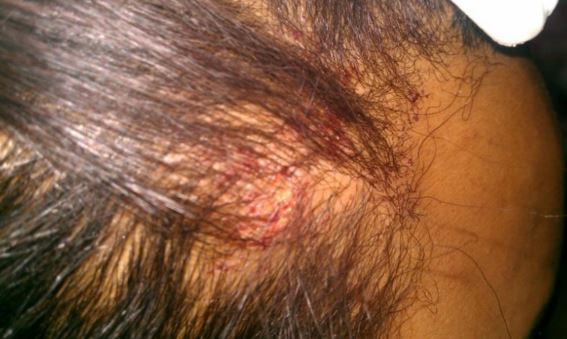
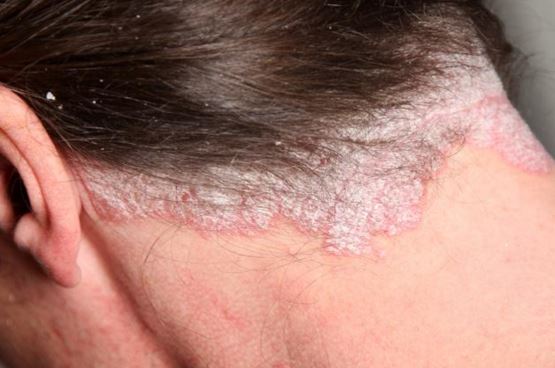
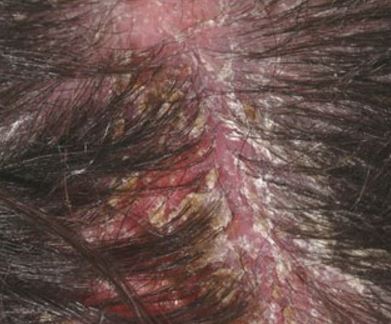
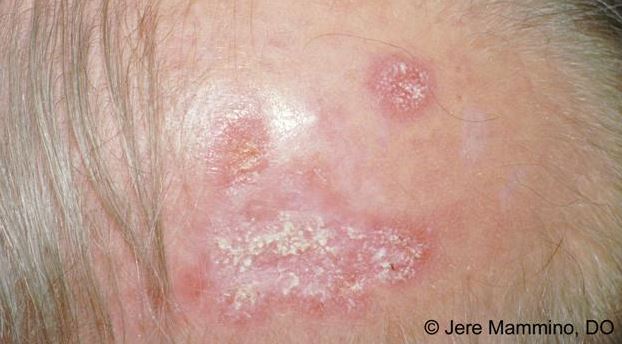
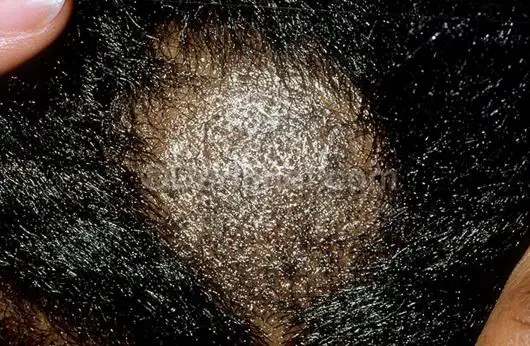
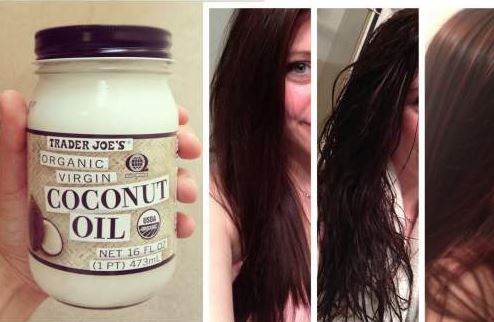
11 comments
My hair from bleaching it does not grow out anymore and it breaks off when I brush it I have little scabs on the back I heard coconut oil works
Ummmmm that’s not normal I bleach mine a lot and that has NEVER happened to me. You need to try taking better care of it with mosterizing treatments and hair masks. I received chemical burns but I still use it jug not on my scalp and I’m fine.
I’m a 76 yr old man in relatively good Heath. Over the past week or so I’ve started to develop a number of reddish / black pimples in various area over the top of my head. In one concentrated area the pimples have ‘scabbed’ but there has been no obvious signs of bleeding. Please help!
Treatment options for dry scalp include glycerin (glycerol) solution. Mix 1/3 glycerin with 2/3 water, by volume. For best freshness, use distilled water. This solution can be used to treat dryness of hands, scalp, and other external skin. Apply after each washing.
My father had dry, thick, bleeding skin on his hands (especially on the palms) which he treated unsuccessfully with cold cream/petrolatum for years. He tried my glycerin advice and his problem cleared up quickly. My own hands never got his dryness problem because I use small bottles of glycerin solution which I keep in bathrooms and kitchen.
I have a rash that is red and red raised bumps that will not go away!! I have delt with this for 5 months going on 6. I have first thoight lice then used lice treatments and all the washing combing. Later to still have these places. I have used coconut oil tea tree oil lemongrass oil vitamin e oil . Cut my hair really short. Still no luck. Combed and combed woth a lice comb. Its not lice. I am thinking could it be a fungus or is it maybe some kinds of parasite or embedding fleas? My toe nails have got really hard and thick with thick skin all around the ends of my toe nails. I dobt no what the heck I have but the hospitals is no help. Please can someone help me?
It sounds like a possible fungal infection, maybe candida yeast.
Tesla did you find out what was causing your scalp and toenails problem? I am a white female 56 and have similar problems
I am a 35 years Type ii diabetic with kidney disease. For the last couple of years I’ve been experiencing these lumps and bumps that weep on my scalp and back. I have tried almost everything from oils to shampoos and nothing helps. Doctors have called it Pruritis and other say it is folliculitis, but no one can come up with a resolution, even light treatment hasn’t helped.
I feel strongly it has to do with the immune system. Four years ago I broke my femur and developed an infection, they treated me with IV Vancomycin, for many weeks which made me sick.
Does anyone have diabetes or kidney failure that might cause these awful never ending bumps? Maybe the vancomycin had something to do with the problem. I am beside myself with this constant scalp problem.
I just started getting bumps and scabs and my head. Only thing I’ve done different
is use coconut oil on all my hair overnight then wash out. I don’t get it.
This method works in 1-3 days. I am a 55 year old male and I have fine to medium hair. You need a live aloe plant with 6″- 8″ stalks and new or sterilized doggie flea comb.
While hair is dry, comb hair with flea comb as you would normally comb your hair. Do not dig into scalp with comb. Just slide comb through hair along top of scalp. If you had not treated SS’s prior to this step you will be surprised at the amount of SS’s the comb grabs. After each stroke, wipe the scabs from the comb and repeat until the comb shows less and less SS’s.
Cut two or three stalks from your Aloe plant. With a pair of scissors cut down the middle of the stalk with the little stalk spikes facing you, or upright. Gently separate from inside out to expose the aloe. Once opened apply to your scalp directly. Don’t try and “scoop out” the aloe, just apply directly from the open, cut stalk, and rub in.
Do this before bedtime/overnight (best) or any time… two, three times a day if you want.
That’s it. My SS’s cleared a lot the first night. I kept on this regime for two more nights and I am clear of SS’s!! Aloe is amazing!
Hi,
I’m going through something very similar now. Though it might not be the same I’m so relieved to hear that your problem got better and have gained some hope for myself as well.